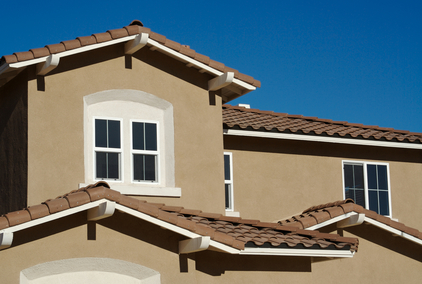Orange County
Clay Roofs vs. Tile Roofs in Orange County
 Tile roofs are some of the most popular options in Orange County, California - and for good reason! They’re long-lasting and incredibly energy-efficient in hotter climates. Plus, they’re a classic look with the area’s typical Spanish-inspired architecture. (But they also look great with more traditional types of architecture.)
Tile roofs are some of the most popular options in Orange County, California - and for good reason! They’re long-lasting and incredibly energy-efficient in hotter climates. Plus, they’re a classic look with the area’s typical Spanish-inspired architecture. (But they also look great with more traditional types of architecture.)
Orange County roofing companies install many of these types of roofs each year. And the best roofing company will walk you through all your available options when it comes to a tile roof. While you’ve got many choices to make when it comes to your new tile roof - from style to color - the first and most basic choice is which type of tile you’ll use.
Tile roofs come in two basic options: concrete and clay. So what’s the difference between the two? Here’s an outline of the basic differences between these two types of tile roofs:
Cost
First, let’s look at the bottom line. Typically, clay tiles are more expensive than concrete. The average cost per square (100 square feet) for clay tiles is $700-$1,000. The average cost per square for concrete tiles is typically $400-$900 per square.
Of course, when comparing costs, it’s important to ask the Orange County roofing companies you’re vetting about the total costs of each type of roof. Also, ask which brands and types of tile they offer in each option. The goal should be to get an idea of overall costs - including installation - and not just costs for the raw materials.
Durability
While both clay and concrete tiles are quite durable, clay is more so. Clay roofs can be expected to last for well over 100 years, while the average lifespan of a concrete roof is about 50 years. Either option gives you much more durability than your average asphalt shingle roof.
Color
Although the most common color for clay roof tiles is terra-cotta - the reddish-brown usually associated with Spanish and Western style architecture - it actually comes in other colors. Natural clay tiles can range from white to yellow to orange to brown. And manufacturers can also add additional pigment to the clay to produce a variety of earth-tones colors. Because clay is naturally pigmented, its colors don’t fade easily.
Concrete tiles can also come in a variety of colors due to dyeing techniques. And today’s technology means that colors are fairly fade-proof. However, concrete tiles are more likely to fade than their clay counterparts.
Porosity
Concrete, you might be surprised to learn, is actually a porous material. This is why concrete tiles don’t last as long as clay. Their porous nature means they’re more likely to fade in color, and they’re also more likely to stain. Clay tiles, on the other hand, aren’t porous, so they don’t stain easily.
Maintenance
In dry areas like SoCal, Orange County roofing companies usually find that the difference in maintenance between concrete and clay tiles is minimal. However, if a rainy season comes along, concrete tiles can be harder to maintain. Because they’re more porous, they’re more likely to invite mold growth. Clay, on the other hand, is virtually maintenance-free, even in wet weather.
Cracking
In one area, concrete tiles actually out-perform clay. When used in cold weather, clay tiles crack and freeze in response to the weather’s changes. But concrete doesn’t respond as much to dramatic temperature changes. So concrete roofing tiles are much better in colder climates, while clay tiles are popular in warmer climates without as much seasonal change.
As with all types of roofing, it’s important to ensure that your particular roofing choice is a good fit for your area, your budget, and your home. So before you choose between clay and concrete tiles, talk with Orange County roofing companies about the options. It’s best to get an in-person quote for different roofing options, so that you know exactly what you’re working with.
Have any more questions about the differences between clay and concrete tile roofs? Ask us in the comments, and we’ll be happy to answer!
If you have any questions, be sure to reach out to Luke Roofing. A long-established Orange County roofer, we provide prompt, reliable expertise for every residential roofing need and situation. Wherever and whenever you need roofing services in Trabuco Canyon or anywhere else in OC, you definitely can count on Luke Roofing.

Comments 2
So on one of our rental properties in Orange County we have a clay tile roof. The roof constantly has mold on it making it look horrible. We had another local Orange County roofing contractor come out and clean it once but its back again and they didn't really give us a long term solution for the issue. It's somewhat close to the beach so there is allot of moisture in the air which is what I think is causing it. Do you have any suggestions with regards to managing this issue more efficiently?
PS. Thanks for the informative article.
Strike that last question. I see now that you have an article on exactly the question I was asking about maintaining a tile roof that has mold on it. Thanks!